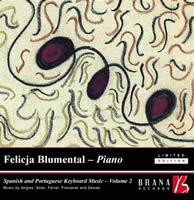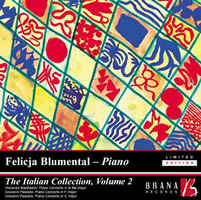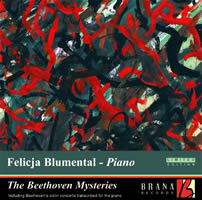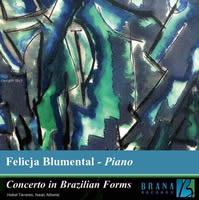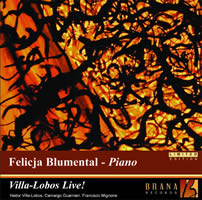Felicja Blumental on BRANA Records
|
Howard Grady Brown [March 2005.] BRANA Records has reissued 20 Felicja Blumental recordings, returning her to the list of virtuoso pianists available to the public. For this the label deserves a round of applause. The ones I sampled were excellent in every way that matters: musicianship, repertoire and, one exception noted, sonics. The recordings date from 1955 for Villa-Lobos’ Piano Concerto No. 5 — a live performance with the Vienna Symphony Orchestra conducted by the composer — to 1972 for the Manfredini Piano Concerto in B flat major. (That’s Vincenzo Manfredini [1737-1799], son of the more prominent Francesco.) Felicja Blumental was born in Warsaw on December 28, 1908. She studied at the National Conservatory, where her teachers included Szymanowski in composition and Joseph Goldberg and Zbigniew Drzewiecki in piano. She was forced to seek refuge in Luxembourg and France at the beginning of World War Two, but by 1942 was in Brazil, where she made a successful debut in Rio de Janeiro. She remained in South America, touring the continent and earning the admiration and respect of Villa-Lobos and a composer new to me, Hekel Tavares. In fact, reviewing these BRANA releases has allowed me to hear music either barely familiar or not at all. Blumental returned to Europe in 1954 and enjoyed a long career, appearing as soloist in recital and with leading orchestras, including the London Symphony Orchestra, the Orchestre National de France, the Philharmonia Orchestra, the Mozarteum Orchestra of Salzburg and the Cleveland Orchestra. She died in Tel Aviv on December 28, 1991 — 83 years to the day after her birth, according to the liner notes for these recordings. Visit BRANA’s website (http://www.branarecords.com/) to hear examples from them. I can recommend all the discs in this survey.
The volumes of Spanish and Portuguese Keyboard Music (BR0021, BR0022), the only solo discs among the group considered here, quickly became favorites of mine and of my wife. Volume One features sonatas, arias and toccatas by Soler, Angles, M. Albéniz, Cantallos and Seixas, Jacinto and Carvalho. All their music, from mid- to late 18th century, shows the influence of Scarlatti, who held posts in Lisbon between 1719 and 1729. The clarity and light I associate with Scarlatti are here — but it is the light of Iberia, and the clear textures reveal distinctive, irregular phrases that haunt the imagination, leaving an impression of modernity unlike anything I have heard in Scarlatti’s sonatas. The great discovery for me is the Portuguese composer, Carlos Seixas (1704-1742). Vol. Two is largely devoted to his music — 13 of the 19 selections. The CD opens with works by Angles, Soler, Ferrer, Freixanet and the ubiquitous Anonymous. Everything is played with the highest level of technical proficiency, and what must be a profound understanding of the idiom. Why not a harpsichord? After all, Penderecki composed his Partita for Harpsichord & Orchestra for Madame Blumental (recorded for EMI). I have no regrets on that score. Her piano playing seems as wedded to this music as Gould’s to Bach. You will want to play these recordings again and again.
The Italian Collection (BR0025, BR0026) features a transcription of Viotti’s Violin Concerto No. 19 in G minor by German pianist / composer Daniel Steibelt and two concertos by Platti. The Torino Symphony Orchestra under Alberto Zedda is featured in the Viotti, while the Salzburg Symphony (Theodore Gulschbauer conducting) is the orchestra in the Platti concertos. The recordings date from 1967 and 1968. The sound is up to BRANA’s standard for all these — very fine, a pleasure to hear. Volume Two includes a concerto by Manfredini and two by Paisiello. The Mozarteum Orchestra of Salzburg (Michiyoshi Inoue cond.) plays in the Manfredini concerto; in the Paisiello Concerto in F major Alberto Zedda conducts the Torino Symphony Orchestra, and Jorg Faerber leads the Wüttemberg Chamber Orchestra in the Concerto in C major. As with the Spanish-Portuguese albums, all the music dates from the 18th century, the composers familiar with the same European courts and impresarios (Salomon in London) known to Haydn, Mozart, Dittersdorf and others of the epoch. Madame Blumental was drawn to the music of this period as strongly as to Chopin, Albéniz, Villa-Lobos and Lutoslawski.
The gem of the lot I sampled — my personal favorite — is the album titled The Beethoven Mysteries (BR0004). However, there is no real mystery to the main offering, the Violin Concerto arranged for piano by the composer. Perhaps the mystery is why a transcription of such extraordinary beauty remains in the shadows. Even the Triple Concerto is more frequently performed and recorded. In fact, the only readily available alternative to Madame Blumental’s recording is a recent Naxos that also includes — yes — the Triple Concerto; the two stepchildren, as it were. Beethoven transcribed many of his works, a well-known example being the Second Symphony in the form of a piano trio. According to the notes that accompany this release, the Violin Concerto’s transcription was better received in its day than in its original form as a Symphony for Violin and Orchestra, so-called owing to the comparative lack of virtuosity required of the soloist. (I leave this to violinists to affirm or dispute.) It never occurred to me that Beethoven’s Violin Concerto was a kind of precursor of Harold in Italy, but the piano part does seem more elaborate than that of the violin in the original. The album notes claim Clementi included this concerto in his repertoire. The original version for violin was apparently composed for Franz Clement, a Viennese theatre concertmaster, reputedly a sensitive though underpowered player. Here, Blumental is supported by the Brno Philharmonic, conducted by Jiri Waldhans. This is a vibrant, pellucid recording. The orchestra reminds me of the NBC Symphony in its best Carnegie Hall tapings — rhythmically precise, excellent ensemble work, chords attacked with exciting unanimity. The piano-timpani dialogue during the first movement’s cadenza presents a marvelous dramatic quality. It has the rhetorical flourish of lines spoken onstage in a play by Schiller, perhaps, or Goethe. Beethoven was certainly familiar with the dramas of both and with the ways of the theatre; the images evoked by this moment were a revelation. The Larghetto lingers magically. You won’t want it to end. The delicacy and simplicity of the playing are a constant source of wonder, and the transition into the Rondo: Allegro is completely delightful. This movement is a very happy conclusion, indeed. The music is allowed to move forward at an easy gait — never pressed, never rushed — a joy to hear. (From October 1967, in Milan.) Again, this is my favorite disc. The mystery suggested in the title really takes form in the companion pieces that conclude matters. The Rondo in B flat major, also recorded in Milan in 1967 with the Brno and Jiri Waldhans, survives in a version by Beethoven’s pupil, Carl Czerny. According to the notes, it’s not known how much of this is Beethoven and how much Czerny. It is known that Czerny added high notes lacking on the early fortepianos available to Beethoven, and he also “enhanced the textures,” though in what ways is not known, since the original has evidently disappeared. In any event, it is an enjoyable and welcome work, complementing the piano concertos in much the way that the Romances fill out the Violin Concerto. The final item on the disc is the opening movement of a piano concerto in D major, dating from 1788 and published in 1890 as an unfinished early composition. As might be expected — and even more than the Second and First Concertos (in order of their composition) — this music reveals the strong influence of Haydn and Mozart in its transparent texture and orderly presentation of themes. The development section anticipates the drama of later work, but the balance favors charm. Every element appears designed to please a genteel audience. At one point this fragment was thought to be the work of a Bohemian composer, Jan Joseph Rosler, and the album notes suggest that the truth may never finally be known — hence the mystery, despite general agreement that the piece is, indeed, by Beethoven. In this recording Madame Blumental is accompanied by the Prague Symphony Orchestra, Alberto Zedda conducting. The performance dates from 1967.
The final two albums are devoted to music of South America and Spain. Concerto in Brazilian Forms (BR0002) takes its name from the opening work, a concerto for piano and orchestra by the Brazilian composer Hekel Tavares. Primarily known as a songwriter (his biggest hit came in 1928), he was also a collector of folk song and related material. As with Villa-Lobos, the movements of his concerto bear both Brazilian and Italian terms. For example, the first movement is titled Modinha: Tempo di batuque (Lento con simplicita). This is not great music, but it’s orchestrated with a sure hand for lush, romantic sound, and is entertaining in the way of Addinsel’s Warsaw Concerto or Gershwin’s Rhapsody in Blue. Though this is a larger work than either of those, it is unabashedly accessible. It was not Tavares’ way to use popular or traditional musics directly, but rather to compose in their spirit. Here Blumental is supported by the London Symphony Orchestra under Anatole Fistoulari. The other pieces on this disc are by Isaac Albéniz: Spanish Rhapsody, Op. 70 and Piano Concerto No. 1 (Concierto fantastico), Op. 80. Luigi Toffolo conducts the Filharmonica Triestina in the former, and Alberto Zedda leads the Torino Orchestra in the latter. This is weightier fare than the Tavares, but no less enjoyable — perhaps more so. The last album considered here is Villa-Lobos Live! (BR0001). It opens with the already-cited Piano Concerto No. 5, dedicated to Madame Blumental. It premiered in London in May 1955; on May 25th of that year, she made this recording at a live performance with the Vienna Symphony, the composer conducting. The album concludes with Villa-Lobos’ Bachianas Brasilieras No. 3, for Piano and Orchestra, and it was her playing of this work in 1954 that caused the composer to take notice of her. Luigi Toffolo conducts the Filharmonica Triestina. Between these two “concertos” are four pieces for solo piano, two by Villa-Lobos and one each by Camargo Guarnieri and Francisco Mignone. The Fifth Piano Concerto is the oldest-sounding recording of the lot. Judging by its constricted dynamic range, I imagine it must have been dubbed from a radio broadcast. Nevertheless, the music and performer come across; this is not your everyday display of Bach-to-Rach. Any of these albums is worth investigating. The music and performers — Felicja Blumental in particular — do their best to please.
[More Howard Grady Brown]
[Previous Article:
Huddersfield Festival 2004: Transpontine Reactions 2.]
[Next Article:
Artur Schnabel's Seven Piano Pieces]
|

